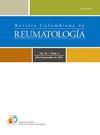Efectividad del uso del parche de trinitrato de glicerilo en el fenómeno de Raynaud secundario
Q3 Health Professions
引用次数: 0
Abstract
Introduction/Objective
Secondary Raynaud's phenomenon is one of the primary cutaneous manifestations of various rheumatological diseases, which can significantly impact quality of life and whose systemic treatment can lead to several adverse effects. Therefore, this study was conducted to assess the effectiveness of glyceryl trinitrate (in transdermal patch form) in patients with secondary Raynaud's phenomenon (SRP), evaluated through vascular flow photoplethysmography.
Materials and methods
A comparative, analytical, open-label, non-randomized study was conducted to evaluate the efficacy of 4.5 mg of glyceryl trinitrate in a transdermal patch placed on the proximal region of one hand in patients diagnosed with SRP compared to the untreated contralateral hand. To determine the primary outcome, vascular flow photoplethysmography assessment was performed 30 days after daily patch use. Secondary results were obtained using an infrared thermometer to measure local temperature in both hands before patch application, 30 minutes after patch use, and at the end of the follow-up period. Additionally, various questionnaires, including the Visual Analogue Scale for pain, Raynaud's Condition Score (RCS), and Dermatology Quality of Life Index (DLQI), were administered on the first and last days of the study.
Results
Sixteen patients, all female, with a median age of 54 years, were included. Regarding the rheumatological diseases associated with secondary Raynaud's phenomenon, twelve patients (75% of the sample) were associated with systemic sclerosis, three patients (19%) with lupus erythematosus, and one (6%) with mixed connective tissue disease (MCTD). There was a significant increase in peripheral blood flow after 30 days of treatment with 4.5 mg of glyceryl trinitrate every 24 hours, along with improvement in clinical symptom and quality of life questionnaires.
Conclusions
This study supports the use of low-dose glyceryl trinitrate via transdermal patches to improve vascular flows, translating into short-term clinical symptom improvement associated with SRP.
三硝酸甘油酯贴片对继发性雷诺现象的疗效
继发性雷诺现象是各种风湿病的主要皮肤表现之一,可显著影响患者的生活质量,其全身治疗可导致多种不良反应。因此,本研究旨在评估三硝酸甘油(透皮贴片形式)对继发性雷诺现象(SRP)患者的有效性,并通过血管血流光容积描记术进行评估。材料与方法进行了一项比较、分析、开放标签、非随机的研究,以评估在诊断为SRP的患者的一只手近端放置4.5 mg三硝酸甘油透皮贴片的疗效,并与未治疗的对侧手进行比较。为了确定主要结果,在每日使用贴片30天后进行血管流量光容积脉搏波评估。在贴片使用前、贴片使用后30分钟和随访结束时,使用红外温度计测量双手局部温度获得次要结果。此外,在研究的第一天和最后一天进行各种问卷调查,包括视觉模拟疼痛量表、雷诺病情评分(RCS)和皮肤病生活质量指数(DLQI)。结果纳入16例患者,均为女性,中位年龄54岁。继发性雷诺现象相关的风湿病中,12例(75%)与系统性硬化症相关,3例(19%)与红斑狼疮相关,1例(6%)与混合性结缔组织病(MCTD)相关。每24小时服用4.5 mg三硝酸甘油治疗30天后,外周血流量显著增加,临床症状和生活质量问卷均有改善。结论:本研究支持使用低剂量三硝酸甘油经皮贴片改善血管流动,转化为与SRP相关的短期临床症状改善。
本文章由计算机程序翻译,如有差异,请以英文原文为准。
求助全文
约1分钟内获得全文
求助全文
来源期刊

Revista Colombiana de Reumatologia
Medicine-Rheumatology
CiteScore
0.80
自引率
0.00%
发文量
92
期刊介绍:
The Colombian Journal of Rheumatology (Revista Colombiana de Reumatología) is the official organ of the Colombian Association of Rheumatology (Asociación Colombiana de Reumatología) and the Central American, Caribbean and Andean Association of Rheumatology (Asociación Centroamericana Caribe Andina de Reumatología) - ACCA. It was created in December 1993 with the purpose of disseminating scientific information derived from primary and secondary research and presenting cases coming from the practice of Rheumatology in Latin America. Since its foundation, the Journal has been characterized by its plurality with subjects of all rheumatic and osteomuscular pathologies, in the form of original articles, historical articles, economic evaluations, and articles of reflection and education in Medicine. It covers an extensive area of topics ranging from the broad spectrum of the clinical aspects of rheumatology and related areas in autoimmunity (both in pediatric and adult pathologies), to aspects of basic sciences. It is an academic tool for the different members of the academic and scientific community at their different levels of training, from undergraduate to post-doctoral degrees, managing to integrate all actors inter and trans disciplinarily. It is intended for rheumatologists, general internists, specialists in related areas, and general practitioners in the country and abroad. It has become an important space in the work of all rheumatologists from Central and South America.
 求助内容:
求助内容: 应助结果提醒方式:
应助结果提醒方式:


